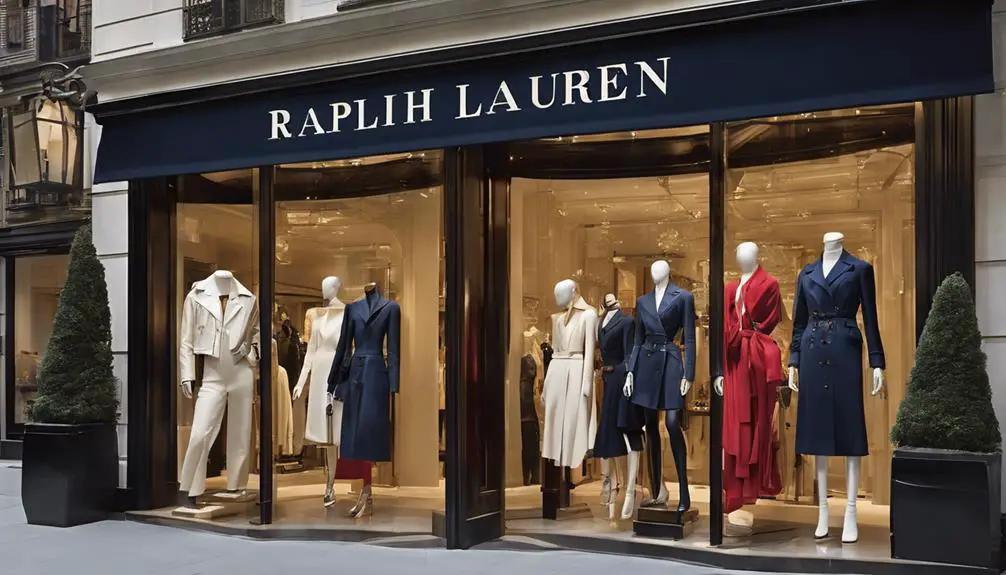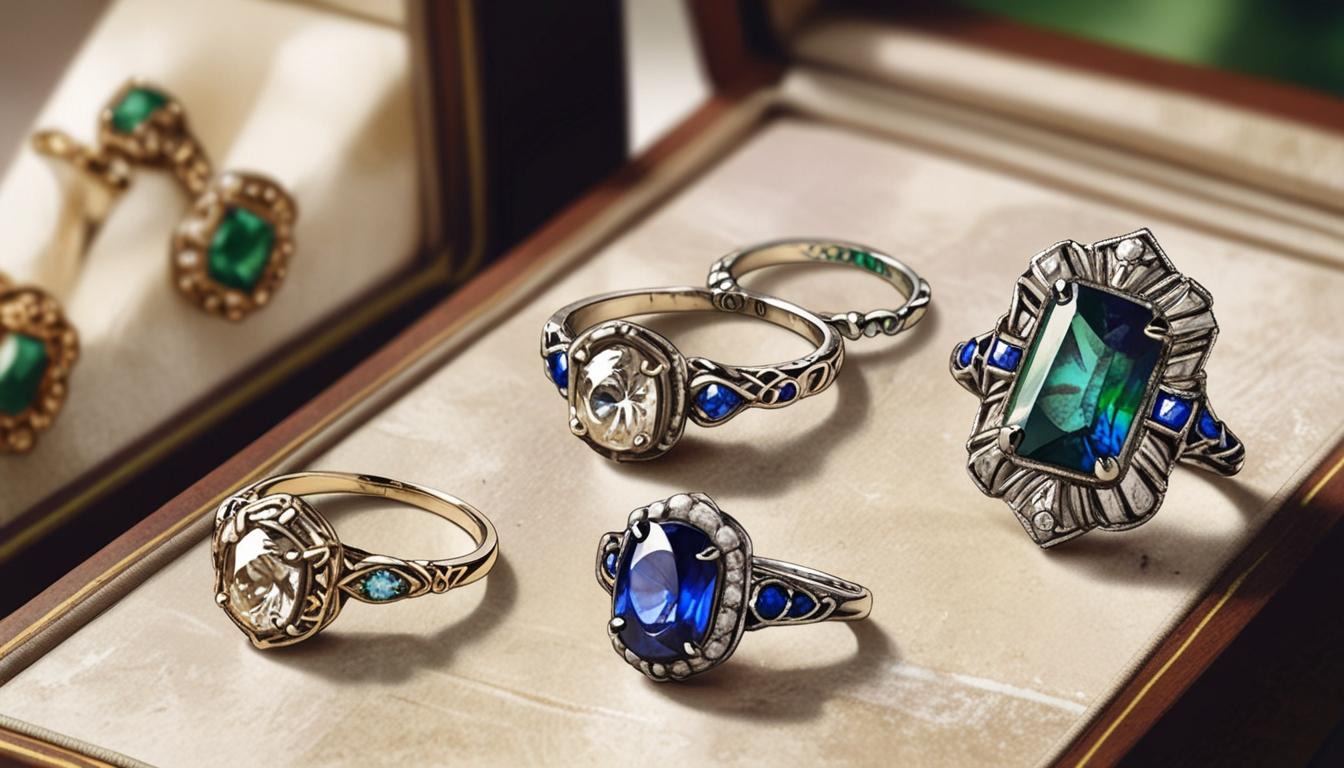You might find it intriguing to learn that Ralph Lauren was founded in 1967, starting with just a line of neckties under the name "Polo." With a modest investment of $50,000, the brand quickly gained momentum, achieving impressive first-year sales. However, what truly set Ralph Lauren apart was its rapid expansion into menswear just a year later, which laid the groundwork for a distinctive brand identity. But how did this initial success lead to the iconic status we recognize today? The journey is filled with pivotal moments that are worth exploring.
Early Beginnings of Ralph Lauren

In 1967, Ralph Lauren began his journey in the fashion world with a simple necktie line under the brand name "Polo," drawing inspiration from the glamour of Old Hollywood. This initial venture paved the way for a remarkable evolution in menswear, as Lauren's tailored styles quickly garnered attention within the industry and among consumers.
By 1968, Lauren launched his first full menswear collection, also named "Polo," officially marking his entry into the competitive fashion industry. You could feel the excitement in the air as the brand began to gain traction, appealing to a public keen for stylish options.
Ralph Lauren's vision extended beyond just ties. In 1969, he opened the first exclusive menswear shop at Bloomingdale's, elevating the brand's visibility and appeal. This move showcased the sophistication and elegance that Polo represented, making it a go-to name for fashionable men.
The excitement didn't stop there; in 1972, the signature cotton mesh polo shirt was introduced. Available in 24 vibrant colors, this iconic piece quickly became a staple of American casual wear, solidifying Polo's reputation in everyday fashion. The Polo shirt's cultural significance has only grown since its launch, becoming synonymous with leisure and luxury.
As the years rolled on, Ralph Lauren Corporation continued to flourish. By 1997, the brand went public, achieving a significant milestone with over $1 billion in sales. This achievement not only highlighted Ralph Lauren's influence in the fashion market but also reaffirmed the enduring legacy he was building through his innovative designs and dedication to quality.
The early beginnings of Ralph Lauren are truly a reflection of ambition, creativity, and the power of style.
Key Milestones in Brand History
Ralph Lauren's journey from a simple necktie line to a global fashion powerhouse is marked by several key milestones that defined the brand's evolution. Founded in 1967, Ralph Lauren initially focused on men's neckties, generating an impressive $500,000 in sales within its first year. This success laid the groundwork for the brand's future endeavors, including the introduction of various sub-brands like Polo Sport that would further enhance its cultural impact.
In 1968, the launch of the first full menswear line, "Polo," was instrumental in establishing the Polo Ralph Lauren identity, bringing a unique blend of sophistication and casual style to the market. The following year, you'd find the brand opening its first exclusive menswear shop at Bloomingdale's, marking a significant milestone in its retail presence.
The introduction of the iconic Polo shirt in 1972 further solidified Ralph Lauren's influence in American style, transforming the shirt into a fashion staple that remains popular to this day.
Fast forward to 1997, when the company went public on the New York Stock Exchange, a proof of its growth and success, boasting over $1 billion in sales.
Here's a quick recap of these milestones:
- 1967: Ralph Lauren is founded, focusing on neckties.
- 1968: The "Polo" menswear line debuts, shaping the brand's identity.
- 1997: The company goes public, showcasing its immense growth.
These milestones illustrate how Ralph Lauren evolved into an iconic brand, reflecting the dynamic interplay between innovation and style in its rich brand history.
Expansion and Retail Presence

Expansion into the retail market has played a crucial role in Ralph Lauren's success. It all began in 1971 when Ralph Lauren opened its first freestanding store on Rodeo Drive in Beverly Hills, marking a considerable step in its retail expansion journey. This store set the stage for a series of strategic moves that would establish the brand's international presence.
Remarkably, the brand's vintage appeal continues to attract customers, as many seek to identify and collect vintage Ralph Lauren pieces. Just a decade later, in 1981, Ralph Lauren ventured into the European market by opening a store in London, further solidifying its foothold overseas.
The brand continued to gain momentum with the launch of its flagship store in the Rhinelander Mansion in New York City in 1986. This iconic location became a crucial retail landmark, showcasing Ralph Lauren's luxurious lifestyle and impeccable style.
By Fiscal 2016, Ralph Lauren had grown to operate 483 directly owned stores globally, alongside 93 stores and 42 dedicated shops run by international partners, demonstrating impressive retail expansion.
With flagship locations in major cities like New York City, Chicago, London, Milan, Tokyo, and Paris, Ralph Lauren has greatly enhanced its global retail footprint. This extensive network not only showcases the brand's exquisite collections but also reinforces its status as a leader in the fashion industry.
Each store serves as a unique expression of Ralph Lauren's vision, inviting customers to immerse themselves in a world of elegance and sophistication that continues to resonate worldwide.
Iconic Products and Collections
Celebrating timeless style and innovation, Ralph Lauren has consistently introduced iconic products that resonate with fashion enthusiasts. Since its inception, the brand has shaped American fashion with a blend of luxury and approachable style.
One of the most notable contributions is the Polo shirt, launched in 1972. Crafted from premium materials and available in a spectrum of colors, it quickly became a staple in countless wardrobes.
In 1972, Ralph Lauren also debuted its first full women's collection, drawing inspiration from menswear, which received rave reviews and established a new standard in women's fashion. The brand continued to innovate with the introduction of Polo Sport in 1992, featuring the Stadium collection known for bold colors and performance-driven activewear.
Aiming for sophistication, Ralph Lauren launched the Purple Label in 1995, emphasizing European tailoring and luxury menswear that speaks to the refined tastes of its clientele.
More recently, the Polo for Women line debuted in 2014, showcased through a stunning 4D water projection fashion show in Central Park, reflecting the brand's commitment to innovative design and enchanting presentations.
Here are some iconic products and collections you might love:
- Polo Shirt: A timeless classic that elevates any outfit.
- Polo Sport: Activewear that combines style and performance.
- Purple Label: The epitome of luxury menswear.
With each release, Ralph Lauren redefines what it means to embrace both luxury and American fashion, making their collections unforgettable.
Philanthropy and Community Engagement

While Ralph Lauren's iconic products reflect a commitment to quality and style, the brand also prioritizes making a positive impact in communities. Through the Ralph Lauren Foundation, the company dedicates significant resources to various philanthropic efforts. One of the pivotal initiatives is the Nina Hyde Center for Breast Cancer Research, co-founded in 1989, which focuses on advancing cancer research and treatment options.
In 2000, Ralph Lauren launched the Pink Pony Campaign, aiming to raise funds for cancer care and tackle disparities in cancer care access. This campaign has been instrumental in providing support to underserved populations, especially through the Ralph Lauren Center for Cancer Care and Prevention, which opened in Harlem in 2003. Here, individuals receive quality cancer services that might otherwise be out of reach.
The brand's commitment to philanthropy extends beyond healthcare; in 2016, Ralph Lauren contributed $13 million to the Save America's Treasures campaign, helping preserve the historic Star-Spangled Banner.
During the COVID-19 pandemic, Ralph Lauren stepped up by donating $10 million and producing medical supplies, showcasing its dedication to community health and safety.
These efforts illustrate that Ralph Lauren isn't just about fashion; it's about fostering meaningful change. Through initiatives like the Pink Pony Campaign and the Ralph Lauren Center for Cancer Care, the brand actively engages in philanthropy, ensuring that it helps create a healthier, more equitable world for all.





A lot of thanks for all your efforts on this web page. My mom takes pleasure in conducting investigations and it’s really easy to understand why. Almost all know all of the dynamic form you convey reliable information on the web blog and as well as recommend response from website visitors about this subject and our favorite child is without question being taught a great deal. Take advantage of the rest of the year. You’re carrying out a really good job.